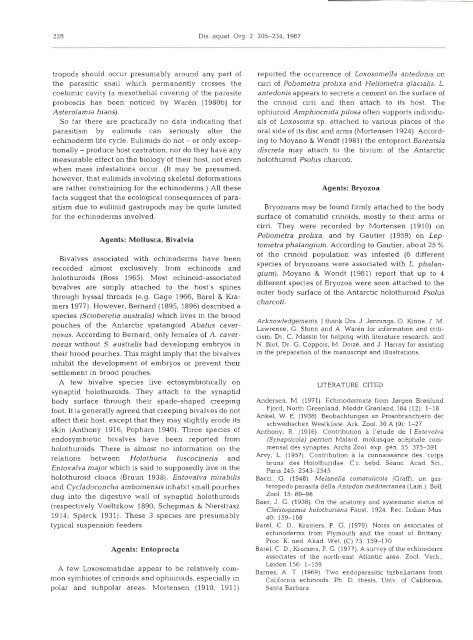Diseases of Echinodermata. 11. Agents metazoans ... - Inter Research
Diseases of Echinodermata. 11. Agents metazoans ... - Inter Research
Diseases of Echinodermata. 11. Agents metazoans ... - Inter Research
Create successful ePaper yourself
Turn your PDF publications into a flip-book with our unique Google optimized e-Paper software.
228 Dis. aquat. Org. 2: 205-234, 1987<br />
tropods should occur presumably around any part <strong>of</strong><br />
the parasitic snail which permanently crosses the<br />
coelomic cavity (a mesothelial covering <strong>of</strong> the parasite<br />
proboscis has been noticed by Waren [1980b] for<br />
Asterolamia hians).<br />
So far there are practically no data indicating that<br />
parasitism by eulimids can seriously alter the<br />
echinoderm life cycle. Eulimids do not - or only excep-<br />
tionally - produce host castration, nor do they have any<br />
measurable effect on the biology <strong>of</strong> their host, not even<br />
when mass infestations occur. (It may be presumed,<br />
however, that eulimids involving skeletal deformations<br />
are rather constraining for the echinoderms.) All these<br />
facts suggest that the ecological consequences <strong>of</strong> para-<br />
sitism due to eulimid gastropods may be quite limited<br />
for the echinoderms involved.<br />
<strong>Agents</strong>: Mollusca. Bivalvia<br />
Bivalves associated with echinoderms have been<br />
recorded almost exclusively from echinoids and<br />
holothuroids (Boss 1965). Most echinoid-associated<br />
bivalves are simply attached to the host's spines<br />
through byssal threads (e.g. Gage 1966, Barel & Kra-<br />
mers 1977). However, Bernard (1895, 1896) described a<br />
species (Scioberetia australis) which lives in the brood<br />
pouches <strong>of</strong> the Antarctic spatangoid Abatus caver-<br />
nosus. According to Bernard, only females <strong>of</strong> A. caver-<br />
nosus without S. australis had developing embryos in<br />
their brood pouches. This might imply that the bivalves<br />
inhibit the development <strong>of</strong> embryos or prevent their<br />
settlement in brood pouches.<br />
A few bivalve species live ectosymbiotically on<br />
synaptid holothuroids. They attach to the synaptid<br />
body surface through their spade-shaped creeping<br />
foot. It is generally agreed that creeping bivalves do not<br />
affect their host, except that they may slightly erode its<br />
skin (Anthony 1916, Popham 1940). Three species <strong>of</strong><br />
endosymbiotic bivalves have been reported from<br />
holothuroids. There is almost no information on the<br />
relations between Holothuria fuscocinena and<br />
Entovalva major which is said to supposedly live in the<br />
holothuroid cloaca (Bruun 1938). Entovalva mirabilis<br />
and Cycladoconcha amboinensis inhabit small pouches<br />
dug into the digestive wall <strong>of</strong> synaptid holothuroids<br />
(respectively Voeltzkow 1890, Schepman & Nierstrasz<br />
1914; Sparck 1931). These 3 species are presumably<br />
typical suspension feeders.<br />
<strong>Agents</strong>: Entoprocta<br />
A few Loxosomatidae appear to be relatively com-<br />
mon symbiotes <strong>of</strong> crinoids and ophiuroids, especially in<br />
polar and subpolar areas. Mortensen (1910, 1911)<br />
reported the occurrence <strong>of</strong> Loxosomella antedonis on<br />
cirri <strong>of</strong> Poliometra prolixa and Heliometra glacialis. L.<br />
antedonis appears to secrete a cement on the surface <strong>of</strong><br />
the crinoid cirri and then attach to its host. The<br />
ophiuroid Amphiocnida pilosa <strong>of</strong>ten supports individu-<br />
als <strong>of</strong> Loxosoma sp. attached to various places <strong>of</strong> the<br />
oral side <strong>of</strong> its disc and arms (Mortensen 1924). Accord-<br />
ing to Moyano & Wendt (1981) the entoproct Barentsia<br />
discreta may attach to the bivium <strong>of</strong> the Antarctic<br />
holothuroid Psolus charcoti.<br />
<strong>Agents</strong>: Bryozoa<br />
Bryozoans may be found firmly attached to the body<br />
surface <strong>of</strong> comatulid crinoids, mostly to their arms or<br />
cirri. They were recorded by Mortensen (1910) on<br />
PoLiometra prolixa, and by Gautier (1959) on Lep-<br />
tometra phalangium. According to Gautier, about 25 %<br />
<strong>of</strong> the cnnoid population was infested (6 different<br />
species <strong>of</strong> bryozoans were associated with L. phalan-<br />
gium). Moyano & Wendt (1981) report that up to 4<br />
different species <strong>of</strong> Bryozoa were seen attached to the<br />
outer body surface <strong>of</strong> the Antarctic holothuroid Psolus<br />
charcoti.<br />
Acknowledgements. I thank Drs. J. Jennings, 0. Kinne, J. M.<br />
Lawrence. G. Shinn and A. Waren for information and criti-<br />
cism; Dr. C. Massin for helping with literature research; and<br />
N. Biot, Dr. G. Coppois. M. Doize, and J. Harray for assisting<br />
In the preparation <strong>of</strong> the manuscript and ilIustrations.<br />
LITERATURE CITED<br />
Andersen, M. (1971). <strong>Echinodermata</strong> from Jsrgen Brenlund<br />
Fjord, North Greenland. Meddr Grenland 184 (12): 1-18<br />
Ankel, W. E. (1938). Beobachtungen an Prosobranchiern der<br />
schwedischen Westkiiste. Ark. Zool. 30 A (9): 1-27<br />
Anthony, R. (1916). Contribution a I'etude de I'Entovolva<br />
(Synapticola) pem-eri Malard, mollusque acephale commensal<br />
des synaptes. Archs Zool. exp. gen. 55: 375-391<br />
Awy, L. (1957). Contribution a la connalssance des 'corps<br />
bruns' des Holothuridae. C.r. hebd. Seanc. Acad. Sci.,<br />
Paris 245: 2543-2545<br />
Bacci, G. (1948). Melanella comatulicola (Graff), un gasteropod~<br />
parasita della Antedon mediterranea (Lam.). Boll.<br />
ZOO^. 15: 89-98<br />
Baer, J. G. (1938). On the anatomy and systematic status <strong>of</strong><br />
Cleistogamia holothuriana Faust, 1924. Rec. Indlan Mus.<br />
40: 159-168<br />
Barel, C. D., Kramers, P. G. (1970). Notes on associates <strong>of</strong><br />
echinoderms from Plymouth and the coast <strong>of</strong> Brittany.<br />
Proc. K. ned. Akad. Wet. (C) 73: 159-170<br />
Barel, C. D., Kramers, P. G. (1977). A survey <strong>of</strong> the echinoderm<br />
associates <strong>of</strong> the north-east Atlantic area. Zool. Verh.,<br />
Leiden 156 1-159<br />
Barnes, A. T (1969). Two endoparasitic turbellarians from<br />
California echinoids. Ph. D. thesis, Univ. <strong>of</strong> California,<br />
Santa Barbara

















